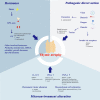Infection-Associated Thymic Atrophy
- PMID: 34113341
- PMCID: PMC8186317
- DOI: 10.3389/fimmu.2021.652538
Infection-Associated Thymic Atrophy
Abstract
The thymus is a vital organ of the immune system that plays an essential role in thymocyte development and maturation. Thymic atrophy occurs with age (physiological thymic atrophy) or as a result of viral, bacterial, parasitic or fungal infection (pathological thymic atrophy). Thymic atrophy directly results in loss of thymocytes and/or destruction of the thymic architecture, and indirectly leads to a decrease in naïve T cells and limited T cell receptor diversity. Thus, it is important to recognize the causes and mechanisms that induce thymic atrophy. In this review, we highlight current progress in infection-associated pathogenic thymic atrophy and discuss its possible mechanisms. In addition, we discuss whether extracellular vesicles/exosomes could be potential carriers of pathogenic substances to the thymus, and potential drugs for the treatment of thymic atrophy. Having acknowledged that most current research is limited to serological aspects, we look forward to the possibility of extending future work regarding the impact of neural modulation on thymic atrophy.
Keywords: atrophy; glucocorticoids; immunosenescence; infections; thymus gland.
Copyright © 2021 Luo, Xu, Qian and Sun.
Conflict of interest statement
The authors declare that the research was conducted in the absence of any commercial or financial relationships that could be construed as a potential conflict of interest.
Figures


Similar articles
-
Streptococcus suis Serotype 2 Infection Causes Host Immunomodulation through Induction of Thymic Atrophy.Infect Immun. 2020 Mar 23;88(4):e00950-19. doi: 10.1128/IAI.00950-19. Print 2020 Mar 23. Infect Immun. 2020. PMID: 31932328 Free PMC article.
-
Epigenetic modifications in thymic epithelial cells: an evolutionary perspective for thymus atrophy.Clin Epigenetics. 2021 Nov 24;13(1):210. doi: 10.1186/s13148-021-01197-0. Clin Epigenetics. 2021. PMID: 34819170 Free PMC article. Review.
-
The thymus is a common target in malnutrition and infection.Br J Nutr. 2007 Oct;98 Suppl 1:S11-6. doi: 10.1017/S0007114507832880. Br J Nutr. 2007. PMID: 17922946 Review.
-
Thymic function is maintained during Salmonella-induced atrophy and recovery.J Immunol. 2012 Nov 1;189(9):4266-74. doi: 10.4049/jimmunol.1200070. Epub 2012 Sep 19. J Immunol. 2012. PMID: 22993205 Free PMC article.
-
Gender Disparity Impacts on Thymus Aging and LHRH Receptor Antagonist-Induced Thymic Reconstitution Following Chemotherapeutic Damage.Front Immunol. 2020 Mar 3;11:302. doi: 10.3389/fimmu.2020.00302. eCollection 2020. Front Immunol. 2020. PMID: 32194555 Free PMC article.
Cited by
-
Immune tolerance and the prevention of autoimmune diseases essentially depend on thymic tissue homeostasis.Front Immunol. 2024 Mar 20;15:1339714. doi: 10.3389/fimmu.2024.1339714. eCollection 2024. Front Immunol. 2024. PMID: 38571951 Free PMC article. Review.
-
Thymic Atrophy and Immune Dysregulation in Infants with Complex Congenital Heart Disease.J Clin Immunol. 2024 Feb 23;44(3):69. doi: 10.1007/s10875-024-01662-4. J Clin Immunol. 2024. PMID: 38393459 Free PMC article.
-
Measuring thymic output across the human lifespan: a critical challenge in laboratory medicine.Geroscience. 2025 Feb 13. doi: 10.1007/s11357-025-01555-3. Online ahead of print. Geroscience. 2025. PMID: 39946072
-
Type 1 immunity enables neonatal thymic ILC1 production.Sci Adv. 2024 Jan 19;10(3):eadh5520. doi: 10.1126/sciadv.adh5520. Epub 2024 Jan 17. Sci Adv. 2024. PMID: 38232171 Free PMC article.
-
Ferroptosis mediated by the IDO1/Kyn/AhR pathway triggers acute thymic involution in sepsis.Cell Death Dis. 2025 Jul 25;16(1):562. doi: 10.1038/s41419-025-07882-9. Cell Death Dis. 2025. PMID: 40715082 Free PMC article.
References
-
- Kindt TJ, Goldsby RA, Osborne BA, Kuby J. Kuby Immunology (2007). Available at: https://books.google.com.hk/books?id=oOsFf2WfE5wC.
Publication types
MeSH terms
LinkOut - more resources
Full Text Sources
Medical

